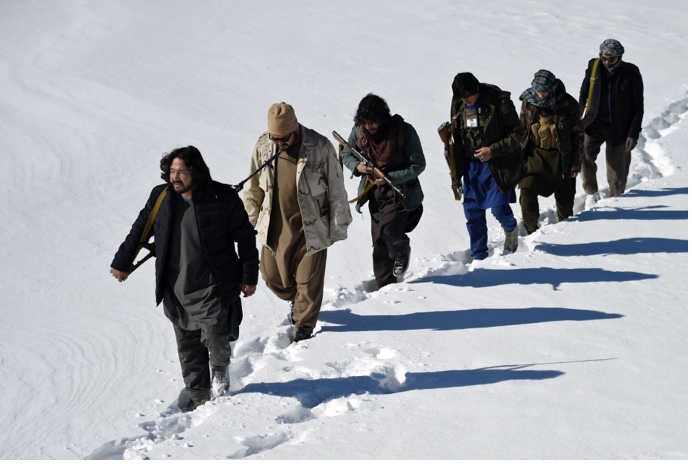Fearing the government will collapse and country may descend again into civil war, Hazaras start to prepare for the worst.

The choice was straightforward for Hamidullah Asadi, a member of Afghanistan’s minority Hazara community – wait for the next deadly attack or join a growing militia.
After spending months recovering from grave injuries after an ISIL (ISIS) suicide attack, he was ready to fight.
“We were forced to take up arms,” said Asadi, now a spokesman for the Resistance for Justice Movement – a band of Hazara fighters based in the war-torn country’s rugged, snow-capped central highlands.
“Our expectations of those who were supposed to defend us were not met.”
Afghan security forces are struggling to hold off an increasingly powerful Taliban as international troops withdraw from the county, with peace talks between the warring sides moving
Fearing the government will collapse and the country may descend again into civil war, Hazaras are starting to prepare for the worst.
Comprising roughly 20 percent of Afghanistan’s 38-million population, Hazaras have long been persecuted for their largely Shia faith in a country racked by deep ethnic divisions.
Asadi was a student at Kabul University in 2016 when he narrowly survived twin suicide blasts at a rally that killed more than 80 people and marked the beginning of a new wave of violence targeting the Hazaras, including assaults claimed by the ISIL armed group.
He says he is now one of the thousands of armed fighters ready to be mobilised by a single call from their commander, Abdul Ghani Alipur, a popular Hazara figure with a Robin Hood-like reputation.
The militia boasts of patrolling roads and launching brazen raids on Taliban areas to abduct the relatives of fighters, later to be used as bargaining chips to release Hazara hostages.
The growth of the militia and similar armed outfits are increasingly problematic for the Afghan government, which is wary of allowing independent fighting forces to build up, but also fears a crackdown would ignite a confrontation with the communities that support them.

The Hazaras have had few allies in Afghanistan over the generations.
During the country’s vicious civil war in the 1990s, they were mercilessly shelled in factional fighting and later massacred in the thousands amid the Taliban’s ruthless conquest of the country.
Few groups, however, have taken as much advantage of the new order established after the overthrow of Taliban rule.
The Hazaras flocked to enrol their children in schools – including their daughters – and entered the political arena in unprecedented numbers.
But those achievements remain fragile.
The group has increasingly taken the brunt of rising violence as ISIL suicide bombers attacked their mosques, schools, rallies and hospitals in western Kabul’s Hazara enclave of Dasht-e-Barchi, killing hundreds.
The Taliban has also kidnapped and killed Hazaras travelling on the country’s perilous roads with near impunity.
“Even with the presence of the US troops or NATO troops in Afghanistan, they were already vulnerable,” said Sima Samar, a leading activist and former head of the Afghan Independent Human Rights Commission.
Some Hazaras have fled the capital for the provinces, including Bamiyan – the Hazara homeland long considered one of Afghanistan’s safest enclaves.
Murad Ali Haidari hoped the move would shield his family from the violence; instead, his son was killed in one of two bombings in the region in November.

Now Bamiyan is dotted with checkpoints, with security forces frequently searching cars and questioning passengers.
“We moved from Kabul to Bamiyan to have better security and live in a peaceful place,” said Haidari.
“Now when we leave home, it is difficult to imagine returning alive.”
Even leaving the country does not guarantee their safety.
A group of Hazara miners – many of whom were Afghan nationals – were brutally massacred in an attack claimed by ISIL in Pakistan last month.
When Hamidullah Rafi’s sister, Rahila, was killed by a suicide bomber at an education centre in Kabul in 2018, he built a new one in her memory.
“It’s a kind of war against ignorance, against the people who kill students, the people who are against education and the empowerment of the youth,” said Rafi.
Like many in Dasht-e-Barchi, he pays several private guards out of his own pocket, citing the government’s inability to secure the area.
But Rafi fears when the US pulls out of Afghanistan, his hand may be forced.
“Will I be forced to take a gun to kill those people who are against me?” he asked. “Maybe.”
Hazara fighter Shawali Nizampoor is more certain and says the community needs to be prepared to defend itself.
“Throughout history, Hazaras have been mistreated in Afghanistan,” said Nizampoor, who joined Alipur’s militia after leaving the country’s official security forces.
“We have to be ready.”
SOURCE : AFP